وثيقة
Towards conservation of Omani local chicken : phenotypic characteristics, management practices and performance traits.
المعرف
DOI: 10.5713/ajas.2013.13541
المساهمون
الناشر
Elsevier.
ميلادي
2014-06
اللغة
الأنجليزية
الموضوع
الملخص الإنجليزي
Characterizing local chicken types and their mostly rural production systems is prerequisite for designing and implementing development and conservation programs. This study evaluated the management practices of small-scale chicken keepers and the phenotypic and production traits of their chickens in Oman, where conservation programs for local livestock breeds have currently started. Free-range scavenging was the dominant production system, and logistic regression analysis showed that socio-economic factors such as training in poultry keeping, household income, income from farming and gender of chicken owners influenced feeding, housing, and health care practices (p<0.05). A large variation in plumage and shank colors, comb types and other phenotypic traits within and between Omani chicken populations were observed. Male and female body weight differed (p<0.05), being 1.3?0.65 kg and 1.1±0.86 kg respectively. Flock size averaged 22?7.7 birds per household with 4.8 hens per cock. Clutch size was 12.3±2.85 and annual production 64.5±2.85 eggs per hen. Egg hatchability averaged 88±6.0% and annual chicken mortality across all age and sex categories was 16±1.4%. The strong involvement of women in chicken keeping makes them key stakeholders in future development and conservation programs, but the latter should be preceded by a comprehensive study of the genetic diversity of the Omani chicken populations.
المجموعة
ISSN
1011-2367
URL المصدر
قالب العنصر
مقالات الدوريات

